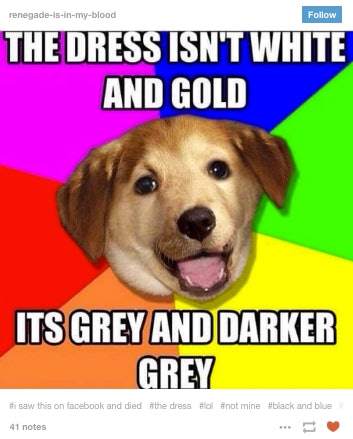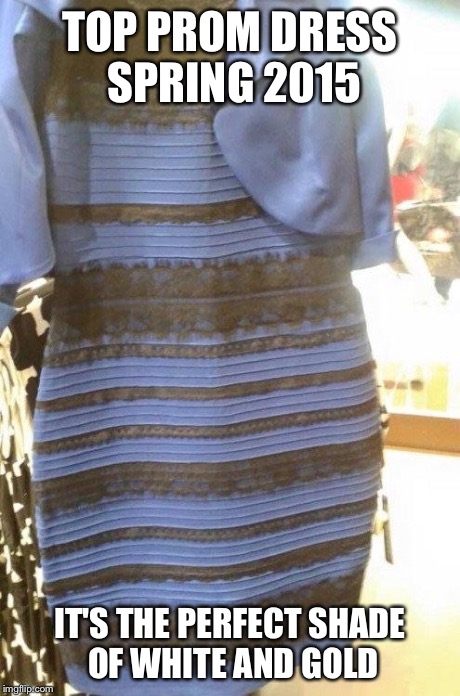Table of Content

There is no one definitive answer to the question of what the “real” color of the illusion dress is. It depends on the specific dress, and on the lighting and angle at which it is viewed. However, it is generally agreed that the colors of illusion dresses appear different in photographs than they do in person. In less than 24 hours, the tweet gained over 7,300 retweets and 3,200 favorites. On February 27th, Redditor AskScienceModerator submitted a post about the dress to the /r/AskScience subreddit, where experts from a variety of fields offered explanations of the color perception phenomenon.

Dress photograph reproduced with permission from the creator Cecilia Bleasdale . "Many said 'pink and brown' or 'pink and a dark color,'" Albany-Ward said. "They are not actually seeing pink, but they think they are. Many people see dark pink when we see blue. But they're not sure if they're seeing blue or pink. They think it should be pink, or they expect us to think it's pink." Carlos Boettcher, a producer with ABC News, is colorblind, especially seeing blurred shades between green with red and blue with purple. So, between the source dress and the photograph dress we have a third dress that is neither one nor the other, which is a combination of qualitative and conceptual effects. "There's no way for me to verify the color that your brain perceives versus the color that my brain perceives," he said.
Mother of the Bride Dresses in Elk River, MN
Answerability judgments are important for decision makers, for example because these judgments affect if additional information should be searched for in order to answer the question correctly, or if the question is already answered with the current information available. As I said, there are a number of things going on in this photograph, but colour constancy is the main one. In the Wired article, you can see that the jacket is reflecting mostly blue light. My visual system interprets the jacket as white but as illuminated by blue light. If you shone a blue light on a white and gold dress, and then took at a photograph of that scene, then you would see that the white stripes reflect blue light and the gold stripes would reflect a very dark, muddy colour, a mixture of blue and dark yellow light. This is why I see The Dress as white and gold, because a white and gold dress, seen under a dim blue light, would look just like this.
Generally speaking, answerability judgments pertain to the issue of whether a question is considered to have a correct answer today, and if not, if it can be answered in the future. By a question being answerable, we mean that “a correct, well-argued, answer at a relevant granularity level can be provided to the question” (Allwood et al., 2016, p. 40). Research has only investigated judgments about the answerability of general knowledge questions (Allwood et al., 2016; Karlsson et al., 2016; Buratti et al., in press). Answerability judgments can also include the belief that a question, due to its nature can never be answered.
Personal tools
What I’ve enjoyed in observing the arguments about this picture across social media is how it can be made to highlight what happens when we misapply our realist intuitions. And Hume and Nietzsche remain entirely relevant to that question. For me it said more about my priors about the internet than about philosophy.

This illustrates that it can make a big difference about what is the rational response in a disagreement when you disagree with one person, or with a whole group of people. In the case of the blue and black dress, the brain interprets the colors differently depending on whether the dress is seen in shadow or in direct light. The blue and black dress illusion highlights the importance of lighting in color perception.
How To Create A Fresh, Natural Looking Burnt Orange Hair Color On Your Own Naturally!
The results showed that as many as 41% of the participants choose the option “there is no correct answer.” Below, we first discuss the results for optimism, then for the effect of previous experience of the photo, followed by a discussion of the additional findings. "The dress" is a viral meme that launched to stardom on 26th February 2015, when the world disagreed over whether the item of clothing below was black and blue or white and gold. The phenomenon revealed differences in human colour perception which have been the subject of ongoing scientific investigation in neuroscience and vision science, with a number of papers published in peer-reviewed science journals. In popular discourse, the disagreement over the colours was sometimes referred to as "dressgate".
I completely agree with you that the question about how we perceive the image is the one that most people are talking about. And as you point out, the “how we perceive” question has gotten a lot of attention from the media. I’m making the claim that that’s not actually the most interesting question (but this is very much a matter of one’s personal philosophical proclivities), and that philosophy might have something to say about other questions that people ought to be asking but aren’t. The phenomenon is interesting and fun, and there are explanations of it at Wired(more science-minded), Vox, and elsewhere. Millions of people are currently obsessed with discussing the dress and figuring out why there is such disagreement about it.
Celebrities with larger Twitter followings began to weigh in overnight. Taylor Swift's tweet—which described how while she saw it as blue and black, the whole thing left her "confused and scared"—was retweeted 111,134 times and liked 154,188 times. Jaden Smith, Frankie Muniz, Demi Lovato, Mindy Kaling, and Justin Bieber agreed that the dress was blue and black, while Anna Kendrick, B. J. Novak, Katy Perry, Julianne Moore, and Sarah Hyland saw it as white and gold.

The philosopher Barry C. Smith compared the phenomenon with Ludwig Wittgenstein and the rabbit–duck illusion, although the rabbit-duck illusion is an ambiguous image where, for most people, the alternative perceptions switch very easily. Our first hypothesis was that more optimistic people to a larger extent than less optimistic people would believe that “there is no correct answer” to the question “What is the correct answer? If this hypothesis is confirmed it would indicate that the relation between optimism and answerability judgments applies to other types of questions than the general knowledge questions used in previous research (Karlsson et al., 2016). Karlsson et al. found that level of optimism was correlated to lower judgments of the answerability today of difficult knowledge questions. The researchers suggested several explanations to why optimists are more likely to believe that no correct answer exists. For example, optimists expect good things to happen in uncertain times (Monzani et al., 2014) which could lead to that they accept and tolerate uncertainty in the environment more than others, such as questions without correct answers.


